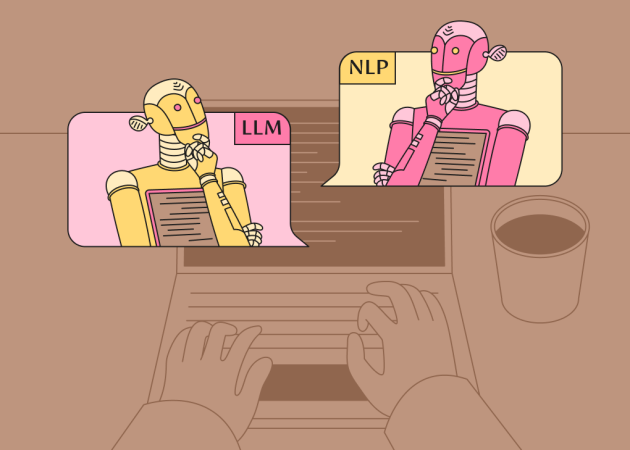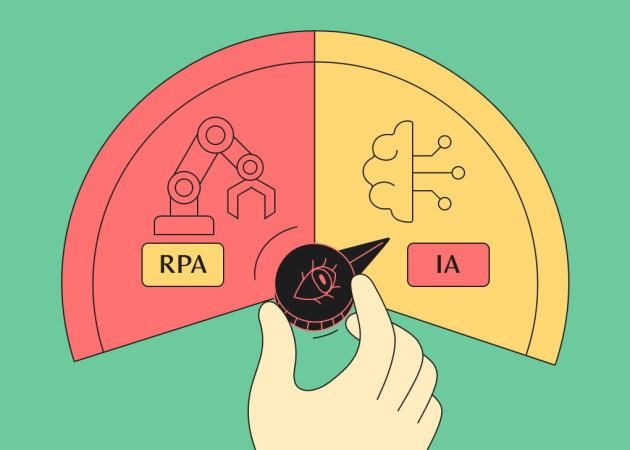
Human-in-the-Loop Meets Agentic AI: Building Trust and Control in Automated Workflows
Contents
Contents
AI, and Generative AI (GenAI) in particular, is evolving fast. However, the value it delivers still depends on maintaining the right degree of control in most cases. That may be why many companies seek a reliable GenAI service provider to improve project vitality and support meaningful human-AI collaboration. Recent analytic overviews highlight these challenges:
- As per The Journal, at least 30% of GenAI initiatives may be abandoned by the end of 2025 owing to poor data, inadequate risk controls, and ambiguous business cases.
- According to Gartner, more than 40% of “agentic AI” projects may be scrapped by 2027 due to cost and unclear business value.
Weak oversight and unclear value are among the leading hypotheses behind stalled AI projects. One practical way to address both is the human-in-the-loop (HITL) approach — a framework that keeps people involved where judgment, ethics, and context are critical in AI systems. In today’s article, we explore what HITL means in practice and how to apply it without undercutting the value of modern AI solutions.
What Is an AI Human-in-the-Loop (HITL) System?
So, what is “human in the loop” after all? A HITL system places people in strategic positions within an AI decision cycle. Instead of allowing a model or agent to act autonomously at every step, the system proposes an action or classification. After that, a designated human reviews, corrects, or approves it.
Human feedback becomes training data that improves future performance. Businesses adopt HITL frameworks to reduce costly errors, handle atypical cases, and align AI decisions with organisational values. The aim is not to micromanage but to balance automation with judgment.
For example, consider customer support. A HITL system lets an assistant draft refund emails. For routine cases, messages are sent automatically. A supervisor reviews the draft, tweaks tone or terms, and approves for partial refunds or policy exceptions. The edit, reason code, and approval path are logged. Future drafts reflect these patterns. As a result, fewer messages need to be reviewed, while sensitive cases still require human judgment.
How the HITL Feedback Loop Works in AI Agent Workflows
The HITL cycle typically unfolds in these four stages:
- An AI model analyzes data and produces an output.
- A human reviewer assesses it, approves or edits it.
- The system records this feedback.
- Governance tools monitor quality, consistency, and bias.
In each context, a targeted human correction helps the model handle edge cases and evolve with real‑world data.

Key Benefits of Implementing a HITL Approach in AI Workflows
Companies add a human-in-the-loop layer to keep automation precise and accountable at the same time. More specifically, keeping human and AI agents in collaboration allows teams to automate manual tasks while keeping high-importance priorities under control. The result is measurable risk reduction without stalling service delivery.
Improving Accuracy and Handling Edge Cases
The latest GenAI models excel at recognizing and mimicking common patterns in customer support, e-commerce cataloging, or document summarization. Where they still fall short, however, is with handling rare but high-impact cases where the cost of error can be fatal:
- In financial services, a misclassified mortgage application may expose lenders to compliance risk.
- In healthcare, a misdiagnosed condition can endanger a patient’s health and life.
- In insurance, a mishandled claim can result in costly disputes, penalties, and financial losses.
High-stakes situations like these cannot pass without direct human oversight and critical judgment. By directing human attention to uncertain outputs — those flagged by rules, thresholds, or model confidence scores — operations teams and product owners can review edge cases, reduce error rates, and gradually expand the scope of what automation can safely handle.
Increasing Trust and Transparency in AI
Different stakeholders need clear reasoning for AI-driven decisions. In finance, bank risk committees and regulators want to know why a loan was declined. In healthcare, hospital compliance officers and clinicians want to see why a system fired an alert. For digital platforms, trust-and-safety leads must be able to justify a takedown.
A HITL layer creates an audit trail, helping provide this visibility: models can propose outcomes, but humans intervene when needed, and every correction is recorded. Decision dashboards trace which inputs influenced the results and document why edits were made. Such transparency builds confidence among customers, regulators, and executives over time.
Continuous Learning and Model Improvement
Each human edit provides a new data point— whether it’s adjusting a classification, clarifying an edge case, or refining a response. Over time, these corrections become valuable training data that inform prompt adjustments, fine‑tuning, and rule updates, supporting continuous learning naturally.
Even without advanced reinforcement learning setups, logging reviewers’ edits and reasoning provides a foundation for ongoing instruction tuning. This process helps AI teams keep their models up-to-date with changing real-world conditions and business needs, ensuring they remain relevant long after initial deployment.
Enhancing AI Safety and Governance
Generative models can produce unpredictable or biased content. That’s why many emerging regulatory frameworks emphasize human oversight. For instance, NIST’s 2024 Generative AI Profile calls for additional review, documentation, and management oversight in critical contexts.
HITL integrates various safeguards by adding compliance checkpoints, privacy controls, and audit trails. For companies in finance, healthcare, or recruitment, such oversight is essential for meeting legal obligations, protecting reputation, and maintaining stakeholders’ trust.
An AI human in the loop design concentrates expert effort where it matters most. When applied thoughtfully, oversight becomes data for learning, not a permanent bottleneck. The result is AI that’s both higher in quality and safer to deploy and use at scale in various scenarios.
Designing Human-in-the-Loop Workflows
Effective HITL strategies focus on when and how to involve people to confirm high-risk actions, correct borderline outputs, approve policy exceptions, and keep systems aligned with human intent. Reviewing every output defeats the purpose of automation. Companies often categorize outputs by risk, route uncertain cases to reviewers, and automate low‑risk decisions. They use confidence thresholds, business rules, and risk tags to determine when a human should step in.
Structured Feedback Is Critical
Systems should capture whether the reviewer approved or edited the output, the reasons for change, and the before/after versions. They should record the model’s confidence and the time spent on review. Collecting this data supports model retraining, surfaces systemic weaknesses, and informs governance. Human involvement becomes a resource for continuous improvement rather than a static checkpoint.
Structured feedback converts expert judgment into high-quality signals for AI. It explains why a change is needed, not just what to change, which improves future decisions. It helps surface and mitigate bias in high-stakes flows like claims processing, lending, and clinical support. Mandatory oversight also supports safety and ethical standards in finance, insurance, and healthcare.
The Architecture Must Support the Workflow
AI agents often operate in plan‑act‑check cycles. HITL integrates at the “check” stage. This is the key aspect of infrastructural integrity:
- Guardrail services filter outputs for toxicity, PII, or policy violations before sending them to humans.
- Policy engines enforce business rules and route exceptions.
- Observability tools log prompts, tool calls, and reviewer actions, enabling drift detection and compliance reporting.
- A data layer stores reviewer edits for supervised training or reinforcement learning from human feedback.
A well-designed HITL workflow aligns review policy, feedback capture, and system architecture. Organizations gain targeted oversight, cleaner training data, and predictable risk. The result is scalable automation with built-in control.
Real-World Examples of HITL in Action
Many companies and organizations already use HITL across different industries and sectors. These are only a few examples of how the strategy creates value:
- Content moderation. Social media platforms, marketplaces, and community forums often use AI to filter spam and harmful content. Humans review borderline cases, refine taxonomies, and provide examples that improve the system. For instance, Meta uses HITL in its hateful conduct strategy. AI flags the content, and a global team of 15,000+ human reviewers deals with enforcements and appeals.
- Healthcare diagnostics. Image‑analysis algorithms highlight anomalies, but specialists confirm or correct the findings, improving sensitivity on rare diseases and increasing trust. This study explains how hospitals managed to decrease workload strain on clinicians by using AI for image analysis.
- Financial compliance. Human and AI agents flag suspicious patterns, and compliance officers decide whether to file a report, ensuring alignment with regulations. For example, a global payment system, Stripe, uses human-AI collaboration to deal with high-risk charges.
- Customer service. Generative AI models draft responses, but supervisors review tone and policy adherence to process refunds or account issues. To illustrate, Zendesk AI agent suggests responses and guidance for human agents. Agents accept, edit, or reject the draft. Approved replies are sent immediately, and the system logs choices and rationales for training and policy updates.
- Procurement and HR. AI analyzes bids or drafts job descriptions, while managers verify fairness, inclusivity, and alignment with corporate values. The UK Ministry of Defense uses its AI-writing assistant, Textio, to write inclusive job adverts, which human agents later review and approve.
When looking at the cases above, it is clear that HITL is not just a hypothesis or an experiment. For many businesses and organizations it already delivers tangible outcomes. However, to achieve similar positive results, one should always have the right implementation roadmap at hand.

Human-in-the-Loop (HITL) Implementation Roadmap
Adopting a human-in-the-loop approach works best in small, measurable steps. Organizations often see better results when they implement HITL gradually, starting with a single, high-impact area, learning from the results, and proceeding with more aspects from there:
Step#1. Scope high‑impact cases
Depending on your industry, start by identifying a process where decisions carry tangible risk. Let’s take, for instance, medical image classification, loan approval, or refund management. Define actions that are fully automated and those routed to human agents. Set initial thresholds by confidence score, amount, or risk tag. Link to business impact: lower charge-offs, fewer clinical misses, reduced refund leakage.
Step #2. Pilot and measure
Run one review lane (a limited pilot) in one domain. Business examples:
- Loan management: Route “borderline” files to credit analysts. Track decision accuracy, turnaround time, and adverse-action quality.
- Medical imaging: Send low-confidence flags to radiologists. Track sensitivity, false-negative rate, and reading time per study.
- Refund processing: Send policy-exception drafts to team leads. Track first-contact resolution, average handling time, and write-off rate.
Tracking how often humans intervene, how long reviews take, and how outcomes improve will help you shape the thresholds and governance rules for subsequent steps and iterations.
Step #3. Iterate and scale
Refine prompts, rules, and thresholds based on review outcomes. As models stabilize and metrics improve, gradually reduce the frequency of human reviews, for example, by sampling only 25% of borderline cases after two stable weeks instead of 100%. The goal is to expand automation carefully, once performance remains consistent and risk is steady, scaling to areas where observed gains justify it.
Step #4. Institutionalize governance
Document data retention, reviewer roles, escalation paths, and incident response as the HITL process matures. Implement bias testing, audit trails, and fairness tests across sensitive attributes, such as protected classes and regulator-ready logs. These measures help make decisions traceable and accountable, whether for financial regulators, medical auditors, or internal ethics boards.
Step #5. Optimize costs
Finally, track how much human reviews cost versus the cost of errors and risks they help mitigate. This step should provide you with enough insights to decide when to scale down manual reviews or invest in targeted training. Human workload should shrink naturally over time, as model confidence grows, to a point where there is a balance between the system’s efficiency and the need for human oversight.
By approaching HITL as a process of iterative learning and gradual expansion, organizations can evolve their safeguards as their systems mature, implementing automation in a way that aligns with real-world expectations, compliance requirements, and business needs.
More insights about budget drivers, tradeoffs, and AI project scoping:
When Organizations Should Consider Human in the Loop AI Automation
In practice, adopting HITL approaches makes the most sense when the cost of risk, uncertainty, or severe consequences in case of a failure outweighs the gains of full automation. Do a little self-test to understand if human oversight is needed in your case:
Can the decision be reversed?
What will a mistake cost you?
Does the process require audit evidence?
If any of the answers raise concerns, then you should keep human oversight part of your workflows — at least, until the quality improves enough to support greater automation. However, certain domains almost always benefit from keeping people in the loop:
- Regulated or ethical contexts. Finance, healthcare, recruitment, and legal decisions must comply with strict guidelines and fairness requirements.
- Brand-sensitive interactions. Customer interactions and public communications can damage trust if mishandled.
- High-cost mistakes. Pricing errors, fraudulent approvals, or data breaches can cause both financial and reputational damage.
- Messy or ambiguous data. Scanned documents, sensor logs, and user‑generated content often require human interpretation.
- Bias and fairness checks. Diverse human perspectives help detect and mitigate algorithmic bias, and surface blind spots that AI models might miss.
As a rule of thumb: If the action is hard to reverse, expensive to fix, or must be explained to a regulator, keep humans in the loop and/or use human-in-the-loop software. Review volume will be reduced as data, prompts, and policies mature, but sampling, audits, and appeal paths should always be in place to preserve accountability.

How Beetroot Can Assist With Responsible AI Development
Integrating human oversight into workflow automation is not only a technical step but also a way of building trust, accountability, and long-term value in agentic solutions. At Beetroot, we collaborate with clients to design HITL approaches that balance automation and human judgment in ways that reflect each organization’s goals and constraints:
- Advisory and risk frameworks. Partner with our teams to define review gates, governance models, and incident response processes that align with industry standards and ethical AI guidelines.
- Engineering and integration. Human-in-the-loop machine learning (ML) solutions improve model accuracy, reliability, and adaptability. As part of this process, we work with clients to embed review pipelines, retrieval, and orchestration layers directly into AI workflows, addressing areas where machines lack contextual understanding.
- Operational support. Oversight data is most useful when it drives continuous improvement. Our teams assist you with designing queues, dashboards, and feedback loops that turn reviewer inputs into structured insights supporting supervised fine‑tuning and reinforcement learning from human feedback (RLHF).
-
Practical decision guidance. We advise you on different ways to improve the existing workflows within your company or organization, whether it’s deciding between building or buying an AI chatbot, choosing an optimal cloud architecture pattern, scoping an AI MVP, or anything in between.
A responsible AI development partner helps ensure that oversight becomes an enabler, not a constraint: turning review data into learning signals, embedding transparency, and helping teams scale automation with confidence and control.
Balancing Innovation With Accountability
AI holds tremendous promise to reshape how businesses operate, yet many projects falter because of:
- High costs;
- Poor data quality;
- Unclear business value.
In a world where AI systems increasingly make decisions on behalf of businesses, success belongs to companies pairing technological innovation with responsible governance. Human-in-the-loop automation software is not a drag on progress. It turns AI into a reliable partner by pairing automation with targeted human judgment.
By adopting the strategy thoughtfully and partnering with experienced vendors, organizations and businesses can get the full potential of agentic AI while keeping control firmly in human hands. If it’s the path you’re exploring, contact us to discuss potential pilots in greater detail.
FAQs
Is human‑in‑the‑loop the same as active learning?
No. Active learning is a data‑collection strategy where the model identifies uncertain items and requests labels for them. It is used mainly during training. HITL is broader. It places humans inside live decision flows to supervise, correct, and approve outputs as they occur. While active learning can be a component of HITL, HITL also covers incident response, governance, and post‑deployment monitoring. Businesses may use active learning to improve models and combine it with HITL to keep live operations safe and compliant.
Doesn’t adding a human slow down the automation process?
HITL introduces human steps, but intelligent routing ensures that only a small subset of outputs requires review. By using confidence thresholds and risk tagging, most low‑risk decisions proceed automatically. Reviewers focus on ambiguous or high‑impact cases. Companies measure median handling times and adjust policies to ensure oversight does not create bottlenecks. Over time, improved models reduce review loads, meaning HITL initially slows throughput but ultimately optimizes speed and quality.
What tasks are best suited for an HITL system?
HITL adds the most value when decisions are high‑stakes or ambiguous. Examples include approving loans, diagnosing medical conditions, moderating sensitive content, issuing refunds, and verifying compliance. Tasks with messy data or unstructured inputs benefit because humans can interpret context. In contrast, routine or reversible decisions with low risk can often be fully automated. Identifying the high‑impact touchpoints helps organizations apply human oversight where it matters most.
How does HITL differ from fully automated AI systems?
Fully automated systems operate without human checkpoints. They rely on pre‑defined thresholds or rules to determine outcomes and are suitable for simple, low‑risk tasks. HITL intentionally inserts humans at critical junctures to catch mistakes, handle nuance, and address ethical or legal concerns.
How do you measure the effectiveness of human involvement in AI workflows?
One can use quantitative and qualitative methods to assess efficiency. Error rates, precision and recall improvement, reduction in false positives or negatives, and shorter turnaround times; these are metrics that allow us to quantify the benefits. How happy reviewers are or how much they trust the people in charge, and whether development is in line with ethical standards. When reviewers examine how often the model they are using and for what reasons, it is a measure of whether the AI can be improved at all. Deciding on the basis of what decision costs and what these results mean for customers gives a view from two different angles.
What are the best practices for selecting human reviewers in an HITL system?
Reviewers are supposed to have domain expertise in the area involved (legal, medical, financial, or content). They should be trained to recognize bias, ensure privacy is protected, and abide by ethical guidelines. Diversity among reviewers can reveal problems missed by a more homogeneous group. Firms need to test blind and calibrate reviewers, and thereby monitor for agreement rates in order to maintain quality. Clear decision rights, escalation paths, and support are necessary, especially in content moderation.
Subscribe to blog updates
Get the best new articles in your inbox. Get the lastest content first.
Recent articles from our magazine
Contact Us
Find out how we can help extend your tech team for sustainable growth.







